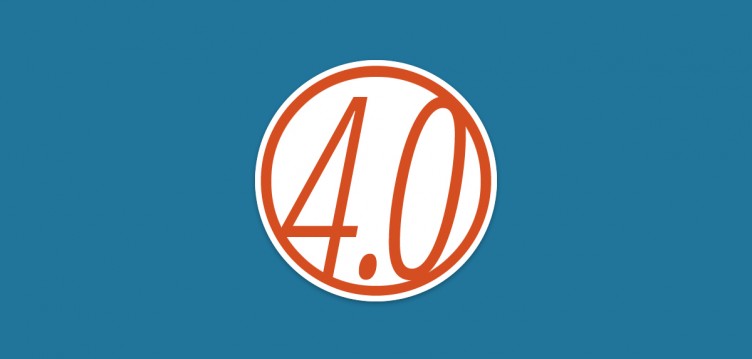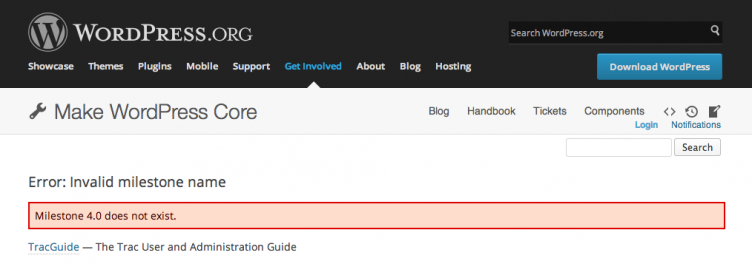 WordPress 3.9 hasn’t quite reached beta, but many of us are already looking ahead to WordPress 4.0. I know, I know: 4.0 is no more significant than 3.9 or any other major release. It just so happens that WordPress’ twenty-third major release will be labeled 4.0.
WordPress 3.9 hasn’t quite reached beta, but many of us are already looking ahead to WordPress 4.0. I know, I know: 4.0 is no more significant than 3.9 or any other major release. It just so happens that WordPress’ twenty-third major release will be labeled 4.0.
But we know — even those of us who know that 4.0 is just 4.0 — that we’ll be just a little more excited about 4.0 than a normal major release. We remember 3.0. It was huge! Multisite, custom post types and many other amazing things we now take for granted were included. But, that doesn’t mean that 4.0 will be so big.
In the stock market, the arbitrary assignment of additional importance to round numbers is called round number bias. The problem is, even though all halfway savvy investors understand this, it doesn’t stop anyone from using round numbers as points of reference and milestones, therefore giving them even further support for importance.
“With shares flirting with $500 again, is it time to buy or time to panic?”
– fool.com talking about Apple.
No matter how much we may want to ignore round numbers, we are drawn to them. They make understanding things easier. And like in the stock market, even though we know 4.0 is just another major release, we want it to be special. We want it to have flair. And I can guess the big tech headlines now. They probably won’t recognize the WordPress version numbering policy at all. They’ll cite the big release of 4.0, and weigh its greatness based on what new major features are included.
Signature features
Pressure for signature features can sometimes make software management difficult. WordPress 3.7 lacked a signature feature, but it was still an incredible release. WordPress 3.8 shipped with the new admin design, so the signature feature was taken care of. But other times, the desire to ship with a signature feature can end up putting so much focus on said feature that other items that should’ve been a lock, end up not getting the attention they otherwise could have. All for the sake of releasing something “sexy”.
Every planning meeting for core development, I see folks in chat wanting to know what the signature feature is going to be.
And in 4.0, expectations will be high. Also, I’ve followed WordPress project lead Matt Mullenweg’s style of leadership for a number of years now, and I think he’ll want to see something really special in 4.0 too.
So, while it may just be another release, I think extra special attention will be given to the signature feature for 4.0.
So what will 4.0 include?
Speculation about what will be included in any release (before the time comes to decide) is poor form. However, that shouldn’t stop us from putting our two cents out there as far as what we’d like to see. Note that I view these as different things. Speculation is the likes of “What’s coming in WordPress 4.0” with a detailed feature list, well before a beta period is underway.
It’s why I do release posts when WordPress is actually released, and not before. The Post Format UI experience in WordPress 3.6 is a perfect example of why I do this. Many posts were prematurely written assuming this feature would ship with 3.6, making it confusing for later readers when the feature was (wisely) pulled from the release.
 Right now, there isn’t even a 4.0 milestone in Trac, which is normal for this time period before a release. Leads have not been assigned. While the core developers and project leads have ideas on what they want to do, the beauty of open source means that this is a great time to weigh in on features you think should be candidates.
Right now, there isn’t even a 4.0 milestone in Trac, which is normal for this time period before a release. Leads have not been assigned. While the core developers and project leads have ideas on what they want to do, the beauty of open source means that this is a great time to weigh in on features you think should be candidates.
Lachlan MacPherson did just that on the Sennza blog. He advocates for inclusion of a JSON API and Content Blocks. I tend to agree with him regarding Ryan McCue’s WP-API. I think it’d make for a powerful addition to WordPress core. However, I think the front-end editing plugin has a better chance of being ready than his proposal for Content Blocks, which seems to have taken a bit of a back seat for now.
I’ve also seen hints that the epic roadmap for taxonomy meta and post relationships could be largely tackled in WordPress 4.0 and 4.1. I would love that.
With the advent of features as plugins, we can gain better understanding of what the future looks like than before. In fact, you can see all plugins under consideration at any given time. If you are thinking about getting involved in major WordPress feature development, this is a great place to start.
You’d also be well served as a WordPress contributor to read Nacin’s thorough guide outlining qualities of a great contributor.
Versions numbers are on their way out
When I asked Andrew Nacin about his thoughts on releases and the significance of 4.0, he responded this way:
Version numbers already don’t matter all that much. Eventually they won’t matter at all.
This could mean that the seamless background update pattern that started with minor versions in WordPress 3.7 is inevitable for major versions in the future. Even if it doesn’t mean automatic background updates, it hints that releases in general will become more regular and updating will be a trivial matter due to the concentration on backwards compatibility and other factors that make updates for some software a pain.
If nothing else gets you excited, this should. Just as version numbers don’t matter any more for our phone apps and the best web browsers, it will eventually be so for WordPress.
Just another epic release
I’d like to propose a shift in our thought process. Countless hours go into developing each WordPress release. Many go to code, but just as many are devoted to documentation, people wrangling, planning, and informing the community.
I think we should all strive to make a better effort to stay informed about upcoming releases. The tools for keeping up and the communication efforts from Make WordPress are at an all time best, I believe.
I know I sometimes become numb to core development cycles. It feels so rapid and so constant that I take it for granted. But I shouldn’t. After all, there are hundreds of real people contributing very real time, and they are helping me make a better living. I should remember more often to embrace their work, thank them, and salute every WordPress release as an epic event.
Whether it’s for WordPress 4.0, or any other release, the community effort that goes into each one is amazing.

Great write up Brian, and thanks for referencing my post. I tend to agree with you that content blocks might be a little too far off in it’s current state, unfortunately it hasn’t really gotten much developer attention after the initial concept. (But that was partly my hope in mentioning the plugin so early on)
Platforms like Medium and Squarespace make content management really easier, and Mark Jaquith’s Velocity Page plugin shows just how far you can take the concept with WordPress. I’d love to see WordPress tackle this sooner rather than later.
Although, taxonomy meta and post relationships would be a solid runner up in terms of features.
I’d loved to see a 3.10.
I came to say the exact same thing.
Particularly because (as mentioned) one can make the case that 3.0 did deserve a major version bump, 3.10 wouldn’t be too hard to justify.
I was hoping to see the metadata API (https://github.com/ericandrewlewis/wordpress-metadata-ui-api) and/or Content Blocks get some attention. I guess every theme on the planet’s framework will continue to do it their own way, most of which are a pain for developers to work with, and I believe are hindering WP’s progress. Of course both these ideas brings no benefit to wordpress.com, so there is also that.
Auto-updates.
I imagine Brian is referring to there not being a shiny UI feature for end-users, and that’s definitely a true statement. And also quite OK — I’m not complaining that auto-updates “just work” and he isn’t either.
Precisely. I think auto-updates are amazing. But not particularly “shiny” for end users, especially when not full of drama and on all updates and not just minor ones 🙂
Great read Brian! I love how you point out how we don’t have to over speculate, when we can see publically a lot of what’s planned and when it’s realistically planned for. Great article 🙂
Hi, Brian!
First, I’m really happy to see a post talking about the Content Blocks User Experience (a.k.a. CEUX) project. I mostly read articles mentioning the Front End Editor (maybe because it’s more ready and it’s actually working right now if you test it). As Lachlan mentioned, the CEUX project hasn’t gotten much developer attention, which is sad because I think that it’s a project that could really change the way that we work with WordPress.
Right now, I think that I’m currently the only one working on CEUX project. I’m really not an expert at working with Javascript libraries like Backbone.js (that powers the current UI of the project), but I’m really learning a lot working on that. And Yes, the project really could use some more devs. This is why I’m so happy to see someone mentioning it!
The development of the project was kept mainly among those who has commit access of the SVN repo of the plugin. But Mel Choyce has made a public repo at Github at the beggining of the project. I currently brought the project to this public repo because I think that it will be easier for anyone that wants to help. I’m working on a fork and doing pull requests as I make some progress on it.
So, for anyone that want to contribute to the project and likes Git / Github, heres the official repo: https://github.com/melchoyce/CEUX
Let’s change the way we work with posts at the Backend!
I want a clean writing mode with markdown support, and live preview. In other words I want Gust as part of core.
I would like to see custom post types & taxonomies along with editable templates as part of the core.
Any time I see WordPress and content blocks I am happy! It doesn’t really matter if 4.0, 4.1, etc are too early for it. Just hoping for ‘soon’ and ‘it will happen’. It would make so much difference in my opinion.
Like a lot of people say whats wrong with 3.10?
I have mixed feelings about the changes to the visual editor. Love the pinned bar, don’t love that I can’t resize the editor window. Might be a bit of OCD for me, but I liked having that control there.
WordPress 3.10 🙂
I like the widget Customization option which was introduced in last version.